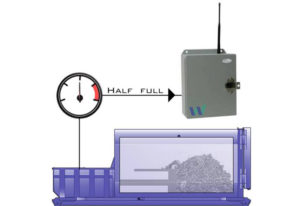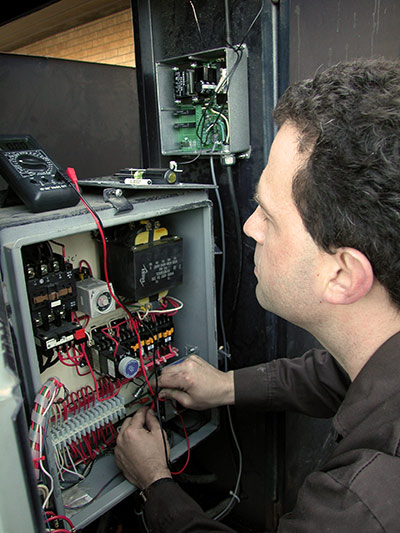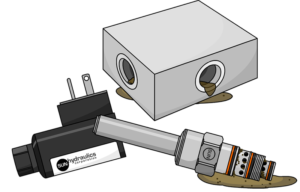Telematics facilitates the exchange of rich data to and from mobile or remote machinery, helping to streamline maintenance and costs.
Contributed by Carl Dyke, CD Industrial Group Inc.
How can the owner of a fleet of cranes avoid the daily worries about whether the machines are being operated and maintained for safe performance? Is there any way a mine manager can track production levels and operator driving habits within a large fleet of $6M haul trucks? Telematics could be the answer.

machinery, as in this garbage compactor here and below.
My first project in telematics was back in 2002. I was tasked to find a way to report the cycles and operating parameters of a hydraulic garbage compactor. The idea was that instead of having a truck scheduled to pick up this giant roll-off unit from the hotel where it was in use and haul it to the local landfill every Thursday, it might be possible to detect remotely when the compactor is actually full, and therefore optimize the hauling schedule.
The main monitoring and reporting unit was fairly straightforward and plain-looking with its flexible rubber-duck style cellular phone antenna sticking out of the top. Inside the shoebox-sized device was a number of connections called inputs. The device, as I recall, only had four digital inputs to detect on-off types of events such as power outages or the push of the start button, and two analog inputs to read variable values such as temperature and pressure.
The installation of the unit was fairly straightforward after getting past the smell of the less-than-new garbage unit. The only invasive task was the installation of a hydraulic pressure transducer to read the compaction cylinder. The company that offered the cellular monitoring and reporting unit featured a website where alarms could be created and where the raw machine usage data could be viewed and analyzed. That’s where the project became interesting.
 After only a few months we knew exactly what times of day and which days of the week saw the most usage for this machine. We soon learned from counting compaction cycles, starting with an empty unit and monitoring hydraulic pressure, just how full the compactor was at any one time. Soon after, we found a way to forward the data directly to a business database for a fleet of compactors. The potential power of this business data was apparent.
After only a few months we knew exactly what times of day and which days of the week saw the most usage for this machine. We soon learned from counting compaction cycles, starting with an empty unit and monitoring hydraulic pressure, just how full the compactor was at any one time. Soon after, we found a way to forward the data directly to a business database for a fleet of compactors. The potential power of this business data was apparent.
Consumer-driven advances
With most current telematics applications featuring global position systems (GPS) and with advanced telematics engineering degrees offered by universities, my example is clearly a very simplistic one. However, the industry and the technology moved very quickly from the early 2000s and the capabilities of telematics has mushroomed. In fact, telematics was underway before the turn of the millennium.

The OnStar system featured in GM products was first released for Cadillac vehicles in late 1996 with only a few simple and important features. This system and ones like it by Ford and Hyundai and others are now thought of as telematics systems. Many readers will identify best with the heavily advertised features such as immediate accident assistance. The accelerometers and other sensors alert the service over a cellular link and an assistant then contacts you by voice to ask if you’ve had an accident and need help. Those same systems now also monitor many parameters of the engine and drivetrain and can contribute to overall vehicle reliability and longevity. While accident assistance is a feature that readily appeals to human emotions, the more common utility and need for control of operating costs through proper maintenance and through good driving habits appeals to one’s wallet. Several insurance companies now offer lower driving insurance rates to drivers who are found to be driving safely within posted speed limits on a consistent basis. Some insurance companies also use data from telematics systems to penalize drivers who do not drive safely. Insurance companies also like the geolocation and asset recovery features that counter problems with theft.
Mobile equipment management

Moving to the arena of industrial mobile equipment where the discipline of asset management is in a continuous state of discussion and learning, we see that companies with a large fleet of trucks or a large collection of mining or construction machines stand to save millions if they have the right data and learn to use it well. So many articles on industrial fleet telematics focus on the giant and obvious wins of fuel savings and warranty period consumption. Both of these issues are about detecting excessive idling periods and then educating operators on how it wastes fuel and about how running hours — which is the common measurement of a warranty period for off-road equipment — uses up the equipment manufacturer’s warranty period early on.
There is no reason not to assume that basic onboard automation will deal with most of this issue and that idled machines will simply be shut down automatically without having to inform management first via telematics. The option for this automation is already available for machine models from a number of manufacturers. Large fleet operators with telematic systems report that the idling time problem is largely conquered as a one-time benefit soon after system installation.
Looking ahead
So what’s coming next then? Let’s think about hydraulic cranes for a moment. I have been asked to work on analysis teams on a few occasions where a hydraulics failure led to the dropping of the boom or a runaway of the main winch. Insanely scary to think about. The companies wished to take whatever steps were possible to prevent a recurrence.
 In one case I was only helping from a distance and in another I was able to get hands-on, but only long after the failure had occurred. I was not the immediate investigator of these failures. Those who did the initial investigation did not leave the crane owners with any confidence that such a disastrous event could be easily detected or warded off in the future. This is an example where telematics has a lot to offer. In both cases, it appeared that a critical valve had become stuck open. Information was brought forward in both cases that the level of particle contaminants in the hydraulic fluid had not been actively monitored and that in fact some system components were known to be worn internally. Those of us who work with hydraulic systems and their maintenance know how much trouble can start with solid contaminant particles within the fluid. These particles can prevent a valve from closing properly. Water contamination is also a serious issue as rust can form internally, then producing extremely hard oxide particles.
In one case I was only helping from a distance and in another I was able to get hands-on, but only long after the failure had occurred. I was not the immediate investigator of these failures. Those who did the initial investigation did not leave the crane owners with any confidence that such a disastrous event could be easily detected or warded off in the future. This is an example where telematics has a lot to offer. In both cases, it appeared that a critical valve had become stuck open. Information was brought forward in both cases that the level of particle contaminants in the hydraulic fluid had not been actively monitored and that in fact some system components were known to be worn internally. Those of us who work with hydraulic systems and their maintenance know how much trouble can start with solid contaminant particles within the fluid. These particles can prevent a valve from closing properly. Water contamination is also a serious issue as rust can form internally, then producing extremely hard oxide particles.
Hydraulic fluid is the lifeblood of the cranes I am writing about. If that blood is not healthy, the whole body, by which I mean the whole machine, will soon be ill. It’s not difficult to maintain the quality of the fluid within the systems of a hydraulic crane, but like human health, internal components are sometimes neglected until it’s too late. The pumps and valves have a factory specified value for how clean and free of contaminants the system fluid must be in order for them to function reliably. The specified value is typically referenced to a standard that is maintained and published by the International Standards Organization (ISO). That standard speaks to how the contaminant particles are detected, counted and grouped by size categories.
Many factories and fleet operators who operate hydraulic machinery are in the habit of sampling the system fluid several times per year and then sending those samples out to a lab for analysis.

The report that is returned usually indicates the level of particle contamination with the fluid, referenced to the ISO standard. In the past, it was only a lab with large, expensive equipment that could analyze and report on the condition of hydraulic fluid. Today a number of compact, affordable devices exist from a variety of manufacturers that allow the level of particle contamination including solids and water to be monitored on a continuous basis. Some of these devices can be integrated into telematic systems with the data viewed and monitored from operations and maintenance offices. Gone are any excuses for neglected hydraulic fluid. If contamination levels suddenly spike upward or even move away from baseline levels, a conscientious maintenance team would presumably investigate immediately. If insurance companies offer discounts to drivers who are found to be driving safely via telematics, perhaps insurance discounts may also be offered to crane owners who are actively found maintaining hydraulic fluid at a high standard of cleanliness.
The use of telematics for heavy equipment manufacturers has also become apparent as hybrid and electric versions have become available for excavators and similar machines. The use of batteries as a power source for propulsion and motion is common to both designs. Battery technology and designs are not yet fully mature for these applications. Telematics can easily transmit the voltage trends and charge state on a cell-by-cell basis to the manufacturers of the machines and the batteries. In this manner, telematics is being used for quality assurance and control.
Production monitoring in large open pit mines has made use of telematics for well over a decade. Current systems use load cells to transmit payload weights from the haul truck to the shovel operator to enable optimal loading of the truck. The business goals are to make sure that truck is fully loaded before it makes its way to the unloading station, and also to make sure that machine-damaging overloads do not occur. Mine production offices use the load data to track overall production.
Mining haul trucks utilize tires that cost over $50,000 each. Getting maximum service life from these consumption items depends on carefully monitoring tire pressure and temperature. While an alert message can easily be displayed to the operator in the cab with only minimal use of telematic technologies, trending and monitoring these parameters from a central point helps management to make decisions on which mine haul roads need grading work to smooth out the potholes that can contribute to tire temperature problems.

Centrally monitored data on tires can also remove the decision making responsibility from the individual operator leaving the matter to management policy for best average cost results. Until all aspects of surface mining become fully automated, telematics will guide and assist human activities that impact business results.
The technology of telematics involving sensors, the transmission of data from multiple machines to and from a central point, and programmed automation are not new technologies. The mobile devices we carry on our persons demonstrate these capabilities to us every day as we move about. The use of telematics for industrial machinery clearly shows off its capabilities in the analysis of data from fleets of machines and the use of that data to change the way the equipment is operated, managed and maintained. It is the thoughtful use of the data for nuanced decision making that shows up as a reduction in safety incidents such as the crane example, and optimal production and the saving of unnecessary expenditures. As telematics make more and more data available, it is up to us humans in the equation to see the potential of that data and use it intelligently to achieve our safety, savings and efficiency goals.

Telematics is already all around us, but it’s up to each purchaser to decide the value of the investment. Consumer-driven advancements focus on emotional appeals to safety, while production-level technology tends to push efficiency and process goals. Both fields coalesce around an interest in saving money. Telematics are already beginning to shift maintenance routines from scheduled to “as-needed,” without sacrificing safety, to conserve production time and parts. When data is used thoughtfully, it allows for a finer level of control, but without the pitfalls of micromanaging each and every piece of equipment. This new superpower will help us continue to make technological leaps while reducing waste and cost.
CD Industrial Group
carldyke.com
LunchBoxSessions.com






